Characteristics
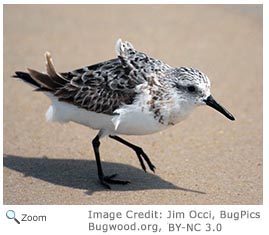 The sanderling is a medium-sized shore bird about 6 inches in length. It has speckled brownish-gray plumage on its uppersides, a dark, pointed bill, black legs and a white belly. In winter, the sanderling's plumage turns grayish-white. The sanderling is a medium-sized shore bird about 6 inches in length. It has speckled brownish-gray plumage on its uppersides, a dark, pointed bill, black legs and a white belly. In winter, the sanderling's plumage turns grayish-white.
Range
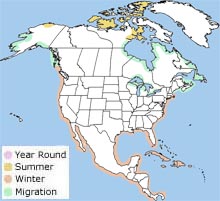 The sanderling breeds on the high arctic tundra of Alaska and northern Canada. It winters along the coast from British Columbia and Massachusetts, south to South America. It is also found in Europe and Asia. The sanderling breeds on the high arctic tundra of Alaska and northern Canada. It winters along the coast from British Columbia and Massachusetts, south to South America. It is also found in Europe and Asia.
Habitat
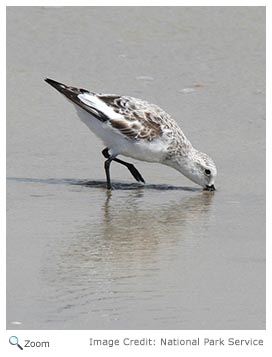 During breeding season, the sanderling lives on the tundra, usually near a freshwater source like a lake or pond. In the winter, it can be found on ocean beaches; sandbars; mudflats and pond, lake and river shores. During breeding season, the sanderling lives on the tundra, usually near a freshwater source like a lake or pond. In the winter, it can be found on ocean beaches; sandbars; mudflats and pond, lake and river shores.
|
|
Diet
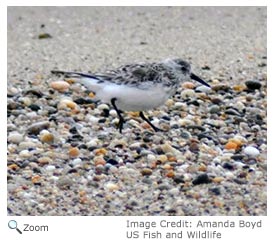 The sanderling eats crustaceans, mollusks, marine worms and insects. The sanderling eats crustaceans, mollusks, marine worms and insects.
Life Cycle Sanderlings arrive in their breeding grounds in the tundra in May or June. During courtship, the male flies up into the air rapidly beating his wings and then flies down vocalizing with a song. He then follows the female with his head down, his tail feathers fanned out and his wings drooping.
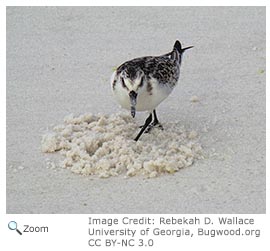 The female sanderling lays four eggs in a hollow in the ground lined with grass and lichen. The chicks hatch after 24-31 days and fledge when they are 17 days old. They leave the nest shortly after hatching and begin searching for insects. Both parents may incubate the eggs and take care of the young. The female sanderling lays four eggs in a hollow in the ground lined with grass and lichen. The chicks hatch after 24-31 days and fledge when they are 17 days old. They leave the nest shortly after hatching and begin searching for insects. Both parents may incubate the eggs and take care of the young.
Behavior
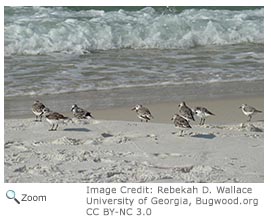 Small groups of sanderlings can often be seen on beaches scurrying after waves as they roll back out to sea. They are actually looking for tiny crustaceans and mollusks exposed by the retreating water. Small groups of sanderlings can often be seen on beaches scurrying after waves as they roll back out to sea. They are actually looking for tiny crustaceans and mollusks exposed by the retreating water.
|